-
REVIEW01-01-2018
Nursing Interventions in the Enhanced Recovery After Surgery®: Scoping Review
Revista Brasileira de Enfermagem. 2018;71:2824-2832
Abstract
REVIEWNursing Interventions in the Enhanced Recovery After Surgery®: Scoping Review
Revista Brasileira de Enfermagem. 2018;71:2824-2832
DOI 10.1590/0034-7167-2018-0436
Views0See moreABSTRACT
Objective:
To identify the Nursing interventions, described in literature, in the ERAS® program.
Method:
We defined a scoping review based on the recommendations of The Institute Joanna Brigs (JBI) and on research in electronic databases. We chose the studies through flow diagrams “Preferred Reporting Items for Systematic Reviews and Meta-Analyses (PRISMA)” and presented them in a chart.
Results:
We found 306 articles published between 2010 and 2018 and included 14 of them. The main results were: the crucial role nurses play throughout the surgical process, which begins at the preoperative nursing consultation; goes to post-operative care, such as early giving food to patients, effective management of pain or early mobilization; and ends in telephone follow-up.
Conclusion:
The introduction of the surgical program ERAS® may be an opportunity for nurses to play a more influential role in the surgical path, directly involving with their clients’ results.

-
REVIEW01-01-2018
Quality of life in children with kidney transplant: Systematic review
Revista Brasileira de Enfermagem. 2018;71:2818-2823
Abstract
REVIEWQuality of life in children with kidney transplant: Systematic review
Revista Brasileira de Enfermagem. 2018;71:2818-2823
DOI 10.1590/0034-7167-2018-0464
Views0See moreABSTRACT
Objective:
To identify in the literature studies that evaluate the quality of life in pediatric patients with kidney transplant through use of specific, validated instruments in Pediatrics.
Method:
Systematic review of the literature with searches conducted in the following databases: Medline, PubMed, LILACS, CINAHL, SciELO and Cochrane Library. Main keywords: Quality of life, Kidney transplantation and Pediatrics.
Results:
A total of 366 studies were selected and eight observational studies were included that evaluated the quality of life of children with kidney transplant by means of evaluation instruments of quality of life.
Conclusion:
The quality of life of children with kidney transplant is inferior compared to healthy children. The post-transplant period presents better results compared to pre-transplant children. The identification of mental, physical and social conditions related to the quality of life of this population allows for better planning the assistance provided to them.

-
REVIEW01-01-2018
Nurses’ contributions to good practices in child care: an integrative literature review
Revista Brasileira de Enfermagem. 2018;71:2808-2817
Abstract
REVIEWNurses’ contributions to good practices in child care: an integrative literature review
Revista Brasileira de Enfermagem. 2018;71:2808-2817
DOI 10.1590/0034-7167-2018-0416
Views1See moreABSTRACT
Objective:
to identify scientific evidence on the contribution of nurses’ work to good practices in child care in the Brazilian literature.
Method:
integrative review of the literature, carried out in Latin American and Caribbean in Health Sciences Literature (LILACS), Medical Literature Analysis and Retrieval System Online (MEDLINE), Brazilian Nursing Database (BDENF), Cumulative Index to Nursing and Allied Health Literature (CINAHL) and Scientific Electronic Library Online (SCIELO) database, from 2008 to 2018.
Results:
14 complete studies were selected for interpretative analysis. Two categories allowed responding to the initial questioning of the study, namely: Nurses’ contributions in child care; and Limits for the nurse’s role in child care.
Conclusion:
evidences show the importance of nurses in child care for the promotion of comprehensive care for children and their families. However, there are socioeconomic, cultural, institutional and technical factors that hinder the nurses’ performance in this setting.

-
REVIEW01-01-2018
Nursing students’ perception about humanized care: an integrative review
Revista Brasileira de Enfermagem. 2018;71:2800-2807
Abstract
REVIEWNursing students’ perception about humanized care: an integrative review
Revista Brasileira de Enfermagem. 2018;71:2800-2807
DOI 10.1590/0034-7167-2017-0845
Views0See moreABSTRACT
Objective:
To analyze the productions of knowledge about the students’ perception of humanized care.
Method:
Study of bibliographical revision of the integrative type. The databases Pubmed, Lilacs, Cuiden and the SciELO virtual library were chosen for selection in October 2017, using the health descriptors “Students, Nursing”, “Perception” and “Humanization of assistance”, in the languages Portuguese, English and Spanish.
Results:
Only eight studies were included that met the objectives of the study, where the majority portrays the Brazilian reality.
Conclusion:
Given the current discussion of society on the subject and the scarcity of publications, it is clear the need to adapt the academic field to complaints of society, as well as reflection of why the problem does not have a significant approach in international setting.
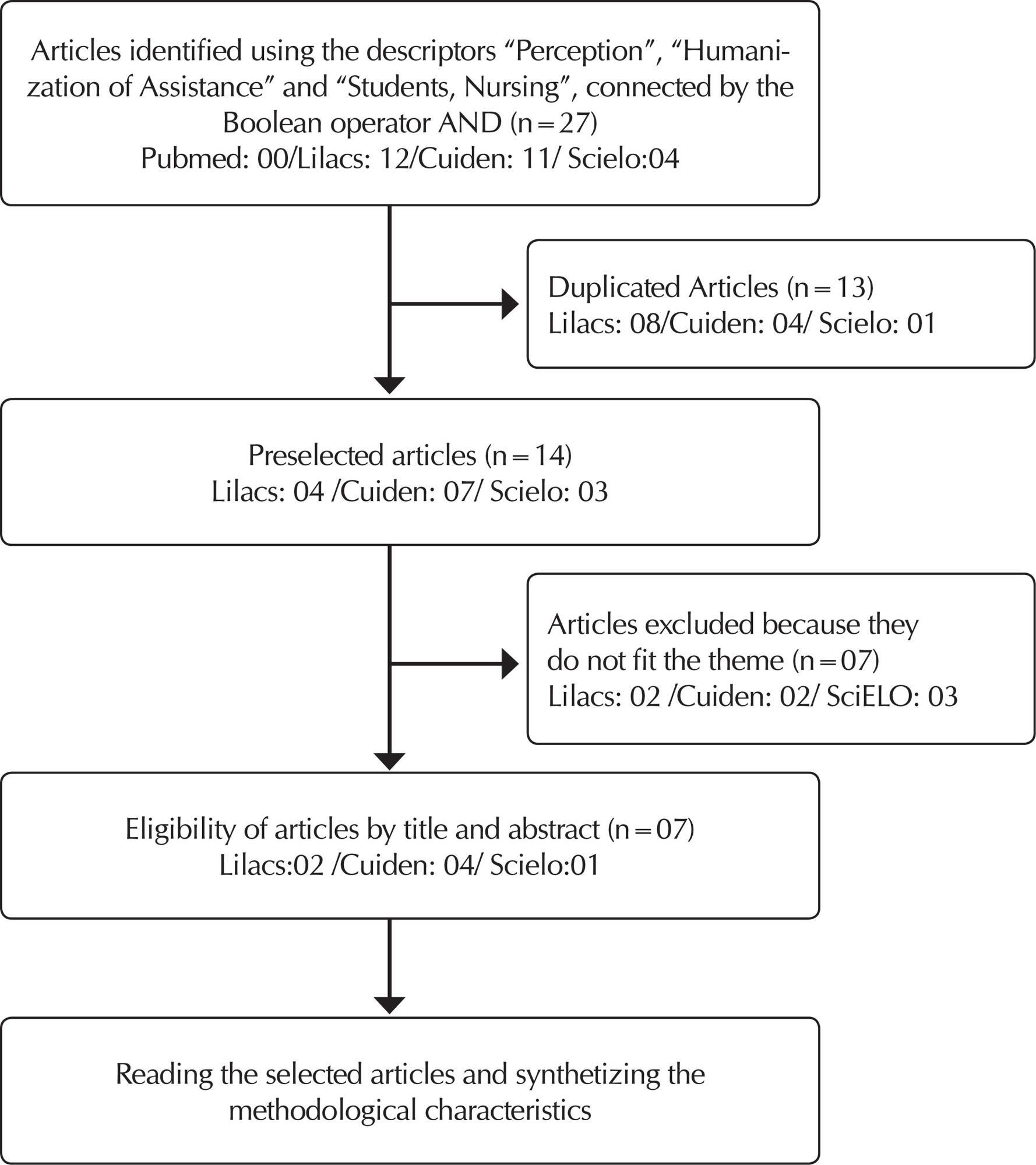
-
RESEARCH01-01-2018
Use of vitamin D and infection in patients with chronic kidney disease
Revista Brasileira de Enfermagem. 2018;71:2792-2799
Abstract
RESEARCHUse of vitamin D and infection in patients with chronic kidney disease
Revista Brasileira de Enfermagem. 2018;71:2792-2799
DOI 10.1590/0034-7167-2018-0640
Views0See moreABSTRACT
Objective:
To evaluate the effectiveness of vitamin D supplementation as protection factor against infection of patients with chronic kidney disease on conservative treatment.
Method:
Retrospective cohort study carried out between 2013 and 2016 in the Conservative Treatment Outpatient Clinics (Ambulatório de Tratamento Conservador) of the Hypertension and Kidney Hospital (Hospital do Rim e Hipertensão) of the Universidade Federal de São Paulo. Data on sociodemographic factors, comorbidity, infection episodes and use or nonuse of vitamin D supplementation for at least 6 months were collected from medical records. The primary outcomes considered in both groups were: presence or absence of infection anywhere on the body (bloodstream, urinary, respiratory and surgical sites).
Results:
A total of 263 patients were included and those who received (n=43) vitamin D had 59% less chance of developing infections (OR=0.41; 95%CI; 0.15-0.99), when compared to those who did not receive.
Conclusion:
Vitamin D supplementation was a protective factor against infections of all causes.
-
RESEARCH01-01-2018
Management challenges for best practices of the Kangaroo Method in the Neonatal ICU
Revista Brasileira de Enfermagem. 2018;71:2783-2791
Abstract
RESEARCHManagement challenges for best practices of the Kangaroo Method in the Neonatal ICU
Revista Brasileira de Enfermagem. 2018;71:2783-2791
DOI 10.1590/0034-7167-2018-0428
Views0See moreABSTRACT
Objective:
To understand the conditions that influence the adherence and application of best practices by nurses in the context of the Nursing care management in the Kangaroo Mother Care in the Neonatal ICU.
Method:
Study of qualitative approach, whose theoretical and methodological frameworks were Symbolic Interactionism and Grounded Theory, respectively. We used the in-depth interview with 8 nurses from the Neonatal ICU of a public maternity hospital in the city of Rio de Janeiro.
Results:
The conditions involved in adhering to the best practices of humanization in the Neonatal ICU are related mainly to human resources, interaction among professionals, work processes and leadership strategies; and care management.
Conclusion:
Professional and institutional challenges have been identified that need to be addressed to improve adherence and implementation of the Kangaroo Mother Care best practices.
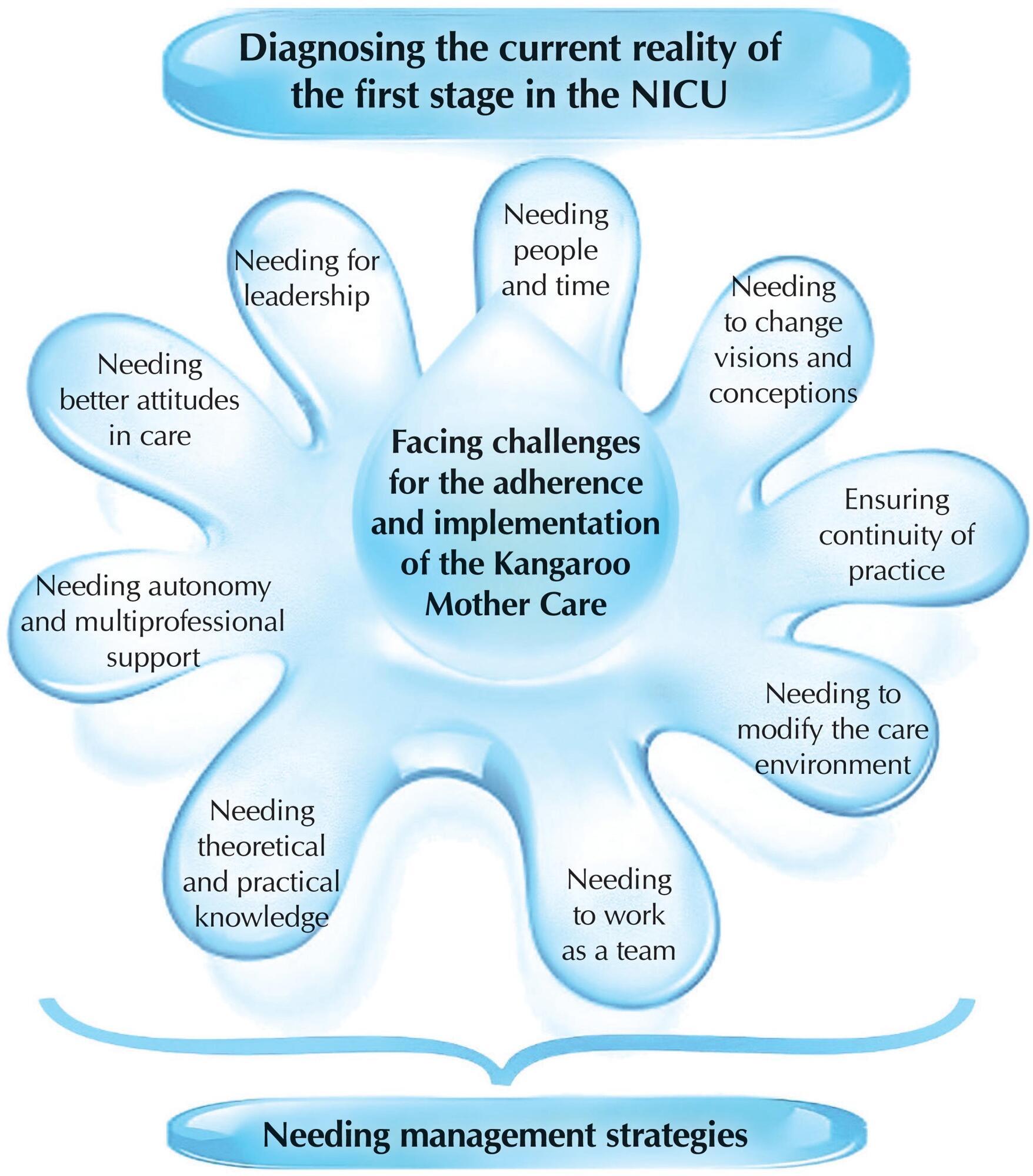
-
RESEARCH01-01-2018
Good practices for patient safety in the operating room: nurses’ recommendations
Revista Brasileira de Enfermagem. 2018;71:2775-2782
Abstract
RESEARCHGood practices for patient safety in the operating room: nurses’ recommendations
Revista Brasileira de Enfermagem. 2018;71:2775-2782
DOI 10.1590/0034-7167-2018-0449
Views0See moreABSTRACT
Objective:
To describe nurses’ recommendations for good patient safety practices in the operating room.
Method:
Quantitative, descriptive and exploratory research developed from an online survey of 220 operating room nurses from different regions of Brazil. The data processing for textual analysis was performed by the software IRAMUTEQ.
Results:
There were eight recommendations: (1) Involvement of the multiprofessional team and the managers of the institution; (2) Establishment of a patient safety culture; (3) Use of the safe surgery checklist; (4) Improvement of interpersonal communication; (5) Expansion of nurses’ performance; (6) Adequate availability of physical, material and human resources; (7) Individual search for professional updating; and (8) Development of continuing education actions.
Conclusion:
These recommendations can be used as care management strategies by nurses for patient safety in the operating room.

-
RESEARCH01-01-2018
The care of nurses in the Family Health Strategy: practices and theoretical foundation
Revista Brasileira de Enfermagem. 2018;71:2767-2774
Abstract
RESEARCHThe care of nurses in the Family Health Strategy: practices and theoretical foundation
Revista Brasileira de Enfermagem. 2018;71:2767-2774
DOI 10.1590/0034-7167-2018-0383
Views0See moreABSTRACT
Objective:
To analyze the practices of nurses working in the Family Health Strategy (FHS) in a city of Rio de Janeiro (RJ) and the theoretical foundations that guide them.
Method:
Qualitative research through semi-structured interviews with twelve nurses working in eleven FHS units between August and December 2014. Data were organized by hermeneutic-dialectical analysis.
Results:
The nurse is inserted in the municipal FHS as care coordinator and political agent; has practices aimed at welcoming, mobilizing social groups, making technical and monitoring of users through health programs. The practices remain in the confrontation of problems and are guided by technical manuals and coordination of health programs.
Final considerations:
Studies are needed to recognize the nurse’s therapeutic objective at the FHS and to propose theoretical foundations, specific to Nursing or Collective Health that will instrumentalize their daily practice.
-
EXPERIENCE REPORT01-01-2018
Clinical and epidemiological teaching of dengue through simulated practice
Revista Brasileira de Enfermagem. 2018;71(2):451-456
Abstract
EXPERIENCE REPORTClinical and epidemiological teaching of dengue through simulated practice
Revista Brasileira de Enfermagem. 2018;71(2):451-456
DOI 10.1590/0034-7167-2016-0503
Views2See moreABSTRACT
Objective:
to describe the experience of clinical teaching on dengue and the practice of epidemiological surveillance using problematization methodology.
Method:
report of experience on educational activity with undergraduate nursing students, held in March 2016, at a public university in the city of São Paulo, conceived in four stages: dialogic lecture, active search of Aedes aegypti, case study and simulation of nursing consultation to individuals with dengue.
Results:
The activity allowed to retrieve previous knowledge about the disease, respond to exercises that addressed different clinical situations and epidemiological surveillance, including in situ evaluation of possible mosquito outbreaks, and discuss the need to expand prevention and health of the individual and the community, the impact of the media in the dissemination of cases and the coping difficulties experienced in the different levels of attention.
Conclusion:
the methodology adopted enabled qualified training of students to cope with dengue.

-
ORIGINAL ARTICLE07-18-2022
Beliefs, knowledge, actions of nursing techniques in breastfeeding in pain management in immunization
Revista Brasileira de Enfermagem. 2022;75(6):e20210546
Abstract
ORIGINAL ARTICLEBeliefs, knowledge, actions of nursing techniques in breastfeeding in pain management in immunization
Revista Brasileira de Enfermagem. 2022;75(6):e20210546
DOI 10.1590/0034-7167-2021-0546
Views1See moreABSTRACT
Objective:
Understand the beliefs, knowledge, and actions of nursing technicians on breastfeeding as a form of non-pharmacological intervention to relieve pain in newborns and infants during immunization.
Methods:
Qualitative study carried out through semi-structured interviews with nine nursing technicians from three Basic Health Units in a city in the state of São Paulo. The theoretical approach of the Belief Model and the methodological framework of Thematic Analysis supported this study.
Results:
Three themes originated: Beliefs, Knowledge, and Actions of nursing technicians.
Final considerations:
Despite knowledge about the benefits of breastfeeding as the most effective method for relieving pain in newborns and infants during vaccination, their restrictive beliefs overrode the evidence, leading them to act in ways that discourage or prevent the mother from breastfeed during vaccination. Formal training is recommended to align with current evidence-based practices.
-
REVIEW12-08-2023
Educational technologies for accident prevention due to falls in childhood: a scoping review
Revista Brasileira de Enfermagem. 2023;76:e20220807
Abstract
REVIEWEducational technologies for accident prevention due to falls in childhood: a scoping review
Revista Brasileira de Enfermagem. 2023;76:e20220807
DOI 10.1590/0034-7167-2022-0807
Views2See moreABSTRACT
Objectives:
to map evidence on educational technology use for accident prevention due to falls in childhood.
Methods:
a scoping review, carried out in October and November 2022, in the MEDLINE, Web of Science, BDENF and CINAHL databases and LILACS bibliographic index. There was no delimitation of language or time. Data were extracted and analyzed descriptively by two independent researchers. The research protocol was registered in the Open Science Framework.
Results:
twenty-six studies were selected. Booklets, pamphlets and leaflets were the most used technologies, presenting health services as the most frequent environment to develop research on fall prevention. The technologies developed were important outcomes: increased knowledge of children, family members, caregivers, health and education professionals.
Conclusions:
educational technology use makes it possible to increase knowledge, adopt safe practices and reduce falls.

-
REVIEW03-15-2024
Resources for health literacy among caregivers of prematurely born children: a scoping review
Revista Brasileira de Enfermagem. 2024;77(1):e20230062
Abstract
REVIEWResources for health literacy among caregivers of prematurely born children: a scoping review
Revista Brasileira de Enfermagem. 2024;77(1):e20230062
DOI 10.1590/0034-7167-2023-0062
Views1See moreABSTRACT
Objectives:
to map the available evidence on resources used to promote health literacy among caregivers of prematurely born children during outpatient follow-up.
Methods:
the Joanna Briggs Institute’s scope review protocol was utilized. The search encompassed six databases, incorporating studies from 2012 to 2022.
Results:
the three included publications revealed that the resources employed are: mobile applications, phone calls, individual counseling, videos, educational pamphlets, and group discussions. Implementing an education protocol during the transition home enhances scientifically grounded health promotion rates.
Conclusions:
there is limited literature addressing the health literacy of these caregivers. The nursing team plays a crucial role in health education and in developing resources applicable to these families.

-
ORIGINAL ARTICLE01-13-2024
Social representations of oncologic surgery for patients with cancer
Revista Brasileira de Enfermagem. 2024;77(6):e20230273
Abstract
ORIGINAL ARTICLESocial representations of oncologic surgery for patients with cancer
Revista Brasileira de Enfermagem. 2024;77(6):e20230273
DOI 10.1590/0034-7167-2023-0273
Views2See moreABSTRACT
Objectives:
to analyze the social representations of patients with cancer regarding oncologic surgery.
Methods:
a qualitative study based on Social Representation Theory was conducted with 126 participants between October 2021 and May 2022 in a public hospital in Rio de Janeiro. A characterization questionnaire, free evocations of the inducing term “surgery”, and semi-structured interviews with 60 participants were applied. Data were analyzed using Microsoft Excel® and IRaMuTeQ.
Results:
the central core of the representation is composed of fear, cure, hope, and removing the disease. The analysis of interviews resulted in six classes that highlight the social changes caused by treatment as well as the need for a support network to cope with the surgical process.
Final Considerations:
the representations reflect fear and hope towards the procedure and the desire to remove the disease, thus translating the cure through surgery.

-
ORIGINAL ARTICLE01-13-2024
Nurses’ perspectives on the use of telemonitoring in the management of people with diabetes and hypertension
Revista Brasileira de Enfermagem. 2024;77(6):e20230481
Abstract
ORIGINAL ARTICLENurses’ perspectives on the use of telemonitoring in the management of people with diabetes and hypertension
Revista Brasileira de Enfermagem. 2024;77(6):e20230481
DOI 10.1590/0034-7167-2023-0481
Views3See moreABSTRACT
Objectives:
to understand the perspective of nurses on the use of telemonitoring in the management of people with type 2 diabetes mellitus and arterial hypertension in primary care.
Methods:
this qualitative research involved sixteen nurses from eight municipalities in Paraná. Data were collected between November 2022 and January 2023 through inperson or remote interviews, which were audio-recorded and subjected to content analysis.
Results:
according to the nurses, telemonitoring enhances users’ knowledge about these conditions, communication and connection with the team, and productivity. However, the lack of electronic resources and equipment, high staff turnover, low user adherence, and the limited availability of professional time present significant challenges.
Final Considerations:
the effective implementation and operation of telemonitoring in the management of people with diabetes and hypertension involve both potential benefits and barriers. It is essential to have the availability of human and technological resources, managerial support, and the commitment of professionals and users.
-
ERRATUM01-13-2024
ERRATUM
Revista Brasileira de Enfermagem. 2024;77(6):e2024n6e08
Abstract
ERRATUMERRATUM
Revista Brasileira de Enfermagem. 2024;77(6):e2024n6e08
DOI 10.1590/0034-7167.20247706e08
Views2In the article “Brazilian nursing specific situation, middle and micro-range theories: a bibliometric study”, with DOI number: , published in Revista Brasileira de Enfermagem, 2024;77(4):e20230520, Chart 1:Where it read:[…]See more -
ORIGINAL ARTICLE09-29-2022
Palliative care production for health professionals in the context of home care
Revista Brasileira de Enfermagem. 2022;75(1):e20210030
Abstract
ORIGINAL ARTICLEPalliative care production for health professionals in the context of home care
Revista Brasileira de Enfermagem. 2022;75(1):e20210030
DOI 10.1590/0034-7167-2021-0030
Views1See moreABSTRACT
Objectives:
to analyze palliative care production developed by health professionals to home care patients.
Methods:
this is an exploratory study, with a qualitative approach, using the transpersonal care theoretical framework. Thirteen interviews were conducted with health professionals and 18 observations were conducted on different cases. Content analysis was performed using MAXQDA©.
Results:
actions performed: maintenance and follow-up measures to people eligible for palliative care, in acts of dialogue and “listening” to caregivers and users, conducting guidelines for the care and self-care process, performing technical procedures, delivery of materials, referrals and medical prescriptions to users.
Final Considerations:
it is perceived the need for advances in the implementation of government policies in Brazil that insert palliative care into the Health Care Network through educational, managerial and care actions that ensure human dignity, thus allowing the development of these and other palliative care interventions.
-
ORIGINAL ARTICLE04-09-2020
High-risk areas of leprosy in Brazil between 2001-2015
Revista Brasileira de Enfermagem. 2020;73(3):e20180583
Abstract
ORIGINAL ARTICLEHigh-risk areas of leprosy in Brazil between 2001-2015
Revista Brasileira de Enfermagem. 2020;73(3):e20180583
DOI 10.1590/0034-7167-2018-0583
Views0See moreABSTRACT
Objectives:
to identify high-risk areas of leprosy in Brazil from 2001 to 2015.
Methods:
this is an ecological study of spatial analysis based on Brazilian municipalities. Spatial scan statistics were used to identify spatial clustering and measure the relative risk from the annual detection rate of new cases of leprosy. By criterion based on the Gini index, only secondary clusters were considered.
Results:
spatial scan statistics detected 26 clusters, in which the detection rate was 59.19 cases per 100 thousand inhabitants, while in the remainder of the country it was 11.76. Large part of the cluster area is located in the Legal Amazon. These groups included only 21.34% of the total population, but 60.40% of the new cases of the disease.
Conclusions:
Leprosy remains concentrated in some areas, showing the need for control programs to intensify actions in these municipalities.
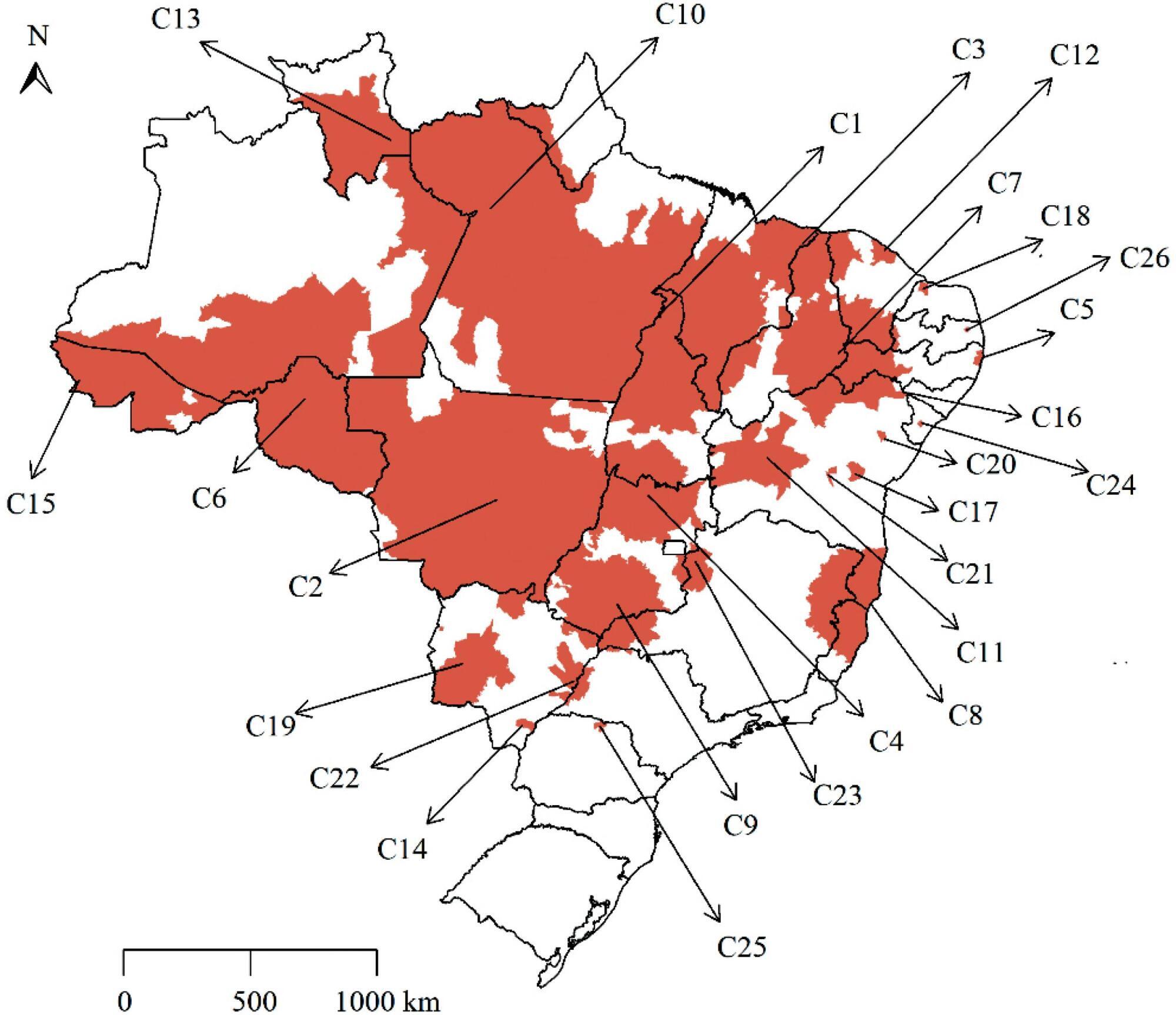
-
REVIEW08-14-2020
Nursing practice environment in Primary Health Care: a scoping review
Revista Brasileira de Enfermagem. 2020;73(6):e20190479
Abstract
REVIEWNursing practice environment in Primary Health Care: a scoping review
Revista Brasileira de Enfermagem. 2020;73(6):e20190479
DOI 10.1590/0034-7167-2019-0479
Views0INTRODUCTIONKnowledge and scientific evidence about nursing practice environments (NPE) in the context of Primary Health Care (PHC) is scarce.Policy makers, health and professional organizations have proposed to redesign the health system in PHC with the aim of increasing citizens’ accessibility, improving customer outcomes and maximizing efficiency. […]See more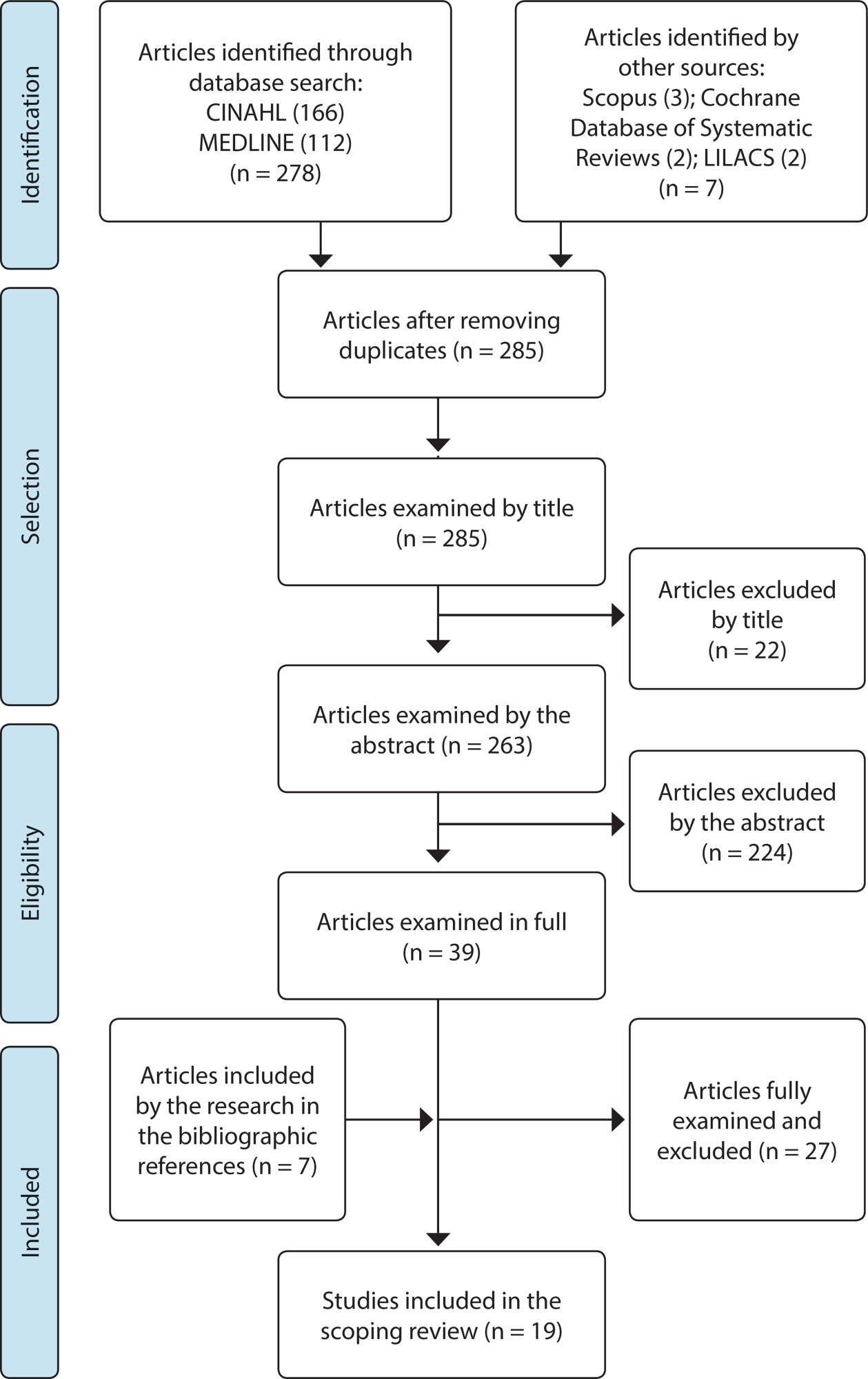
-
ORIGINAL ARTICLE12-13-2019
Perceptions and expectations of pregnant women about the type of birth
Revista Brasileira de Enfermagem. 2019;72:41-49
Abstract
ORIGINAL ARTICLEPerceptions and expectations of pregnant women about the type of birth
Revista Brasileira de Enfermagem. 2019;72:41-49
DOI 10.1590/0034-7167-2017-0731
Views0See moreABSTRACT
Objective:
to understand the perceptions and expectations of pregnant women about the type of birth.
Method:
this is a qualitative research, based on the assumptions of the Humanization of Obstetric Care. 15 pregnant women were interviewed twice at the beginning and the end of gestation between October 2015 and May 2016. Data were analyzed according to the method of the Discourse of the Collective Subject.
Results:
the discourses were associated with four themes: Advantages of vaginal birth over cesarean section; Fear and unpredictability of vaginal birth; Importance of the doctor in the definition of the type of birth; and Influence of family and friends in choosing the type of birth.
Final considerations:
according to pregnant women, vaginal birth has more benefit compared to cesarean section. However, during gestation and birth, fear of pain and the unexpected, and medical opinions of friends and family against vaginal birth strongly influence the choice of cesarean section.
-
REVIEW09-30-2020
Telenursing in care, education and management in Latin America and the Caribbean: an integrative review
Revista Brasileira de Enfermagem. 2020;73:e20190317
Abstract
REVIEWTelenursing in care, education and management in Latin America and the Caribbean: an integrative review
Revista Brasileira de Enfermagem. 2020;73:e20190317
DOI 10.1590/0034-7167-2019-0317
Views0See moreABSTRACT
Objective:
Analyze the knowledge generated about telenursing related to the roles of nurses (care, education and management) in Latin America and the Caribbean, based on scientific evidence.
Methods:
Integrative review, for the years 2009 to 2019, in scientific databases from Latin America and the Caribbean. Twelve articles were selected.
Results:
Nine studies focused on care and three on education. The information and communication technology used in the studies was telephony directed toward non-communicable diseases. There were concerns about the remote communication process. With respect to education, two focused on educating health teams and one on educating patients.
Conclusion:
It is necessary to conduct studies on telenursing that generate changes in care practices, explore information and communication technology resources and provide communication training focused on this new care model.
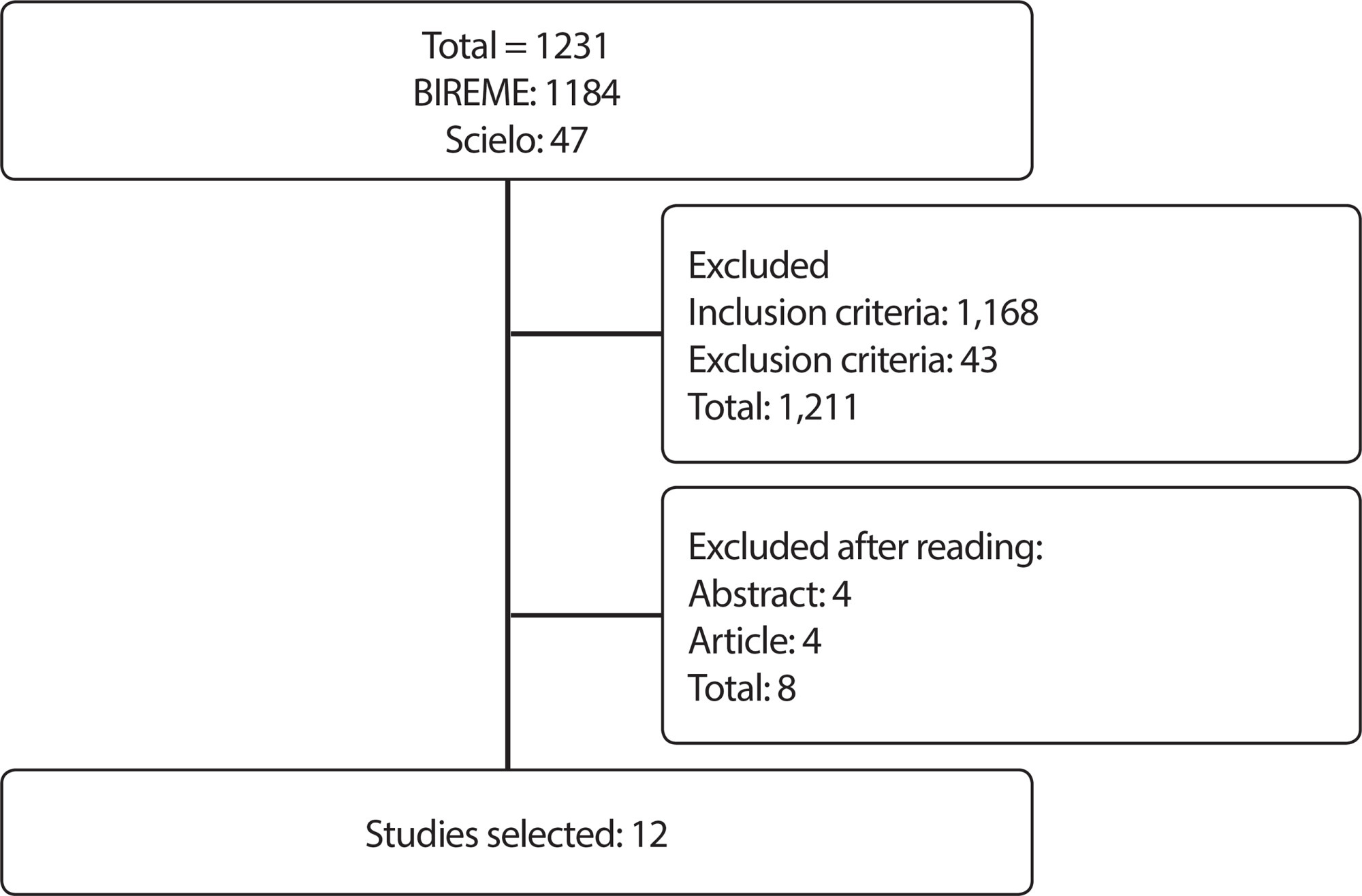
-
REVIEW04-16-2021
Clinical outcomes of patient navigation performed by nurses in the oncology setting: an integrative review
Revista Brasileira de Enfermagem. 2021;74(2):e20190804
Abstract
REVIEWClinical outcomes of patient navigation performed by nurses in the oncology setting: an integrative review
Revista Brasileira de Enfermagem. 2021;74(2):e20190804
DOI 10.1590/0034-7167-2019-0804
Views0See moreABSTRACT
Objective:
to evidence the clinical outcomes of navigation performed by nurses in cancer patients.
Methods:
this is an integrative literature review with collection in MEDLINE via PUBMED, LILACS, Web of Science, Scopus, and CINAHL databases. The final sample consisted of seven studies. The data were analyzed and presented descriptively. Data related to clinical outcomes were compiled and described in full. The Agency for Healthcare Research and Quality categorization was used to assess the level of evidence.
Results:
the clinical outcomes demonstrated were decreased distress, anxiety and depression, improved control and management of symptoms, improved physical conditioning, improved quality and continuity of care, improved quality of life, reduced time to start treatment.
Final considerations:
there is research that shows better clinical outcomes in cancer patients through navigation by nurses across the continuum of health care.
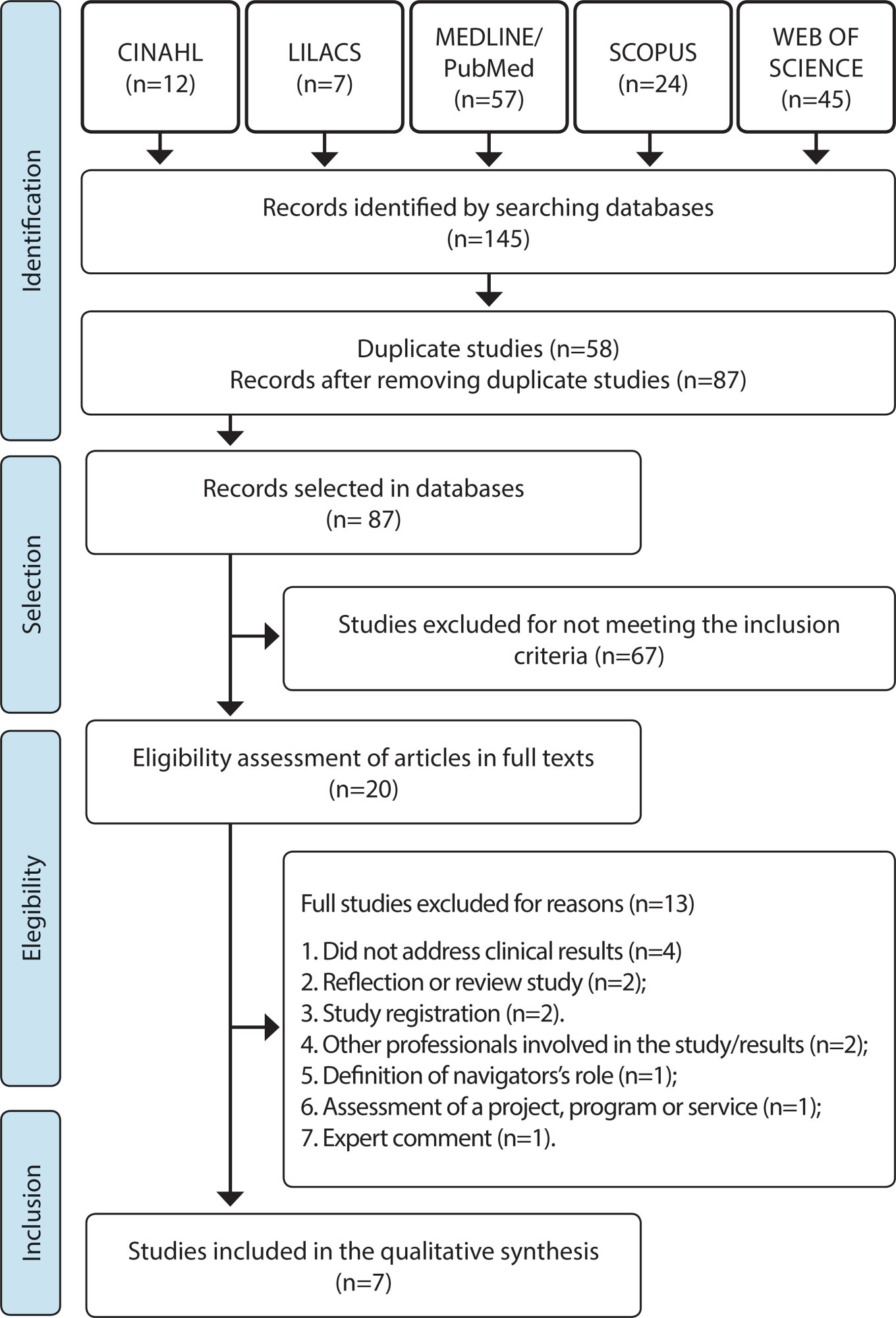
-
ORIGINAL ARTICLE06-29-2020
Personal Protective Equipment in the coronavirus pandemic: training with Rapid Cycle Deliberate Practice
Revista Brasileira de Enfermagem. 2020;73:e20200303
Abstract
ORIGINAL ARTICLEPersonal Protective Equipment in the coronavirus pandemic: training with Rapid Cycle Deliberate Practice
Revista Brasileira de Enfermagem. 2020;73:e20200303
DOI 10.1590/0034-7167-2020-0303
Views0See moreABSTRACT
Objective:
to discuss the application of Rapid Cycle Deliberate Practice for attire and unattire training in the context of COVID-19 and structure a practical guide to the application at this juncture.
Methods:
this methodological study described theoretical and practical aspects of the application of a simulation strategy as a technological training tool. An application guide was constructed from the search for evidence from the main health authority bodies in Brazil.
Results:
maximizing time in Deliberate Practice, feedback with evidence and psychological security are the principles of this strategy. The dynamic involves repetition and feedback. The application guide presents the sequence of actions for attire and unattire.
Final considerations:
coping with this pandemic requires appropriate use of personal protective equipment. The authors suggest the Rapid Cycle Deliberate Practice as a technological educational tool for attire/unattire, since it encourages mastery performance.
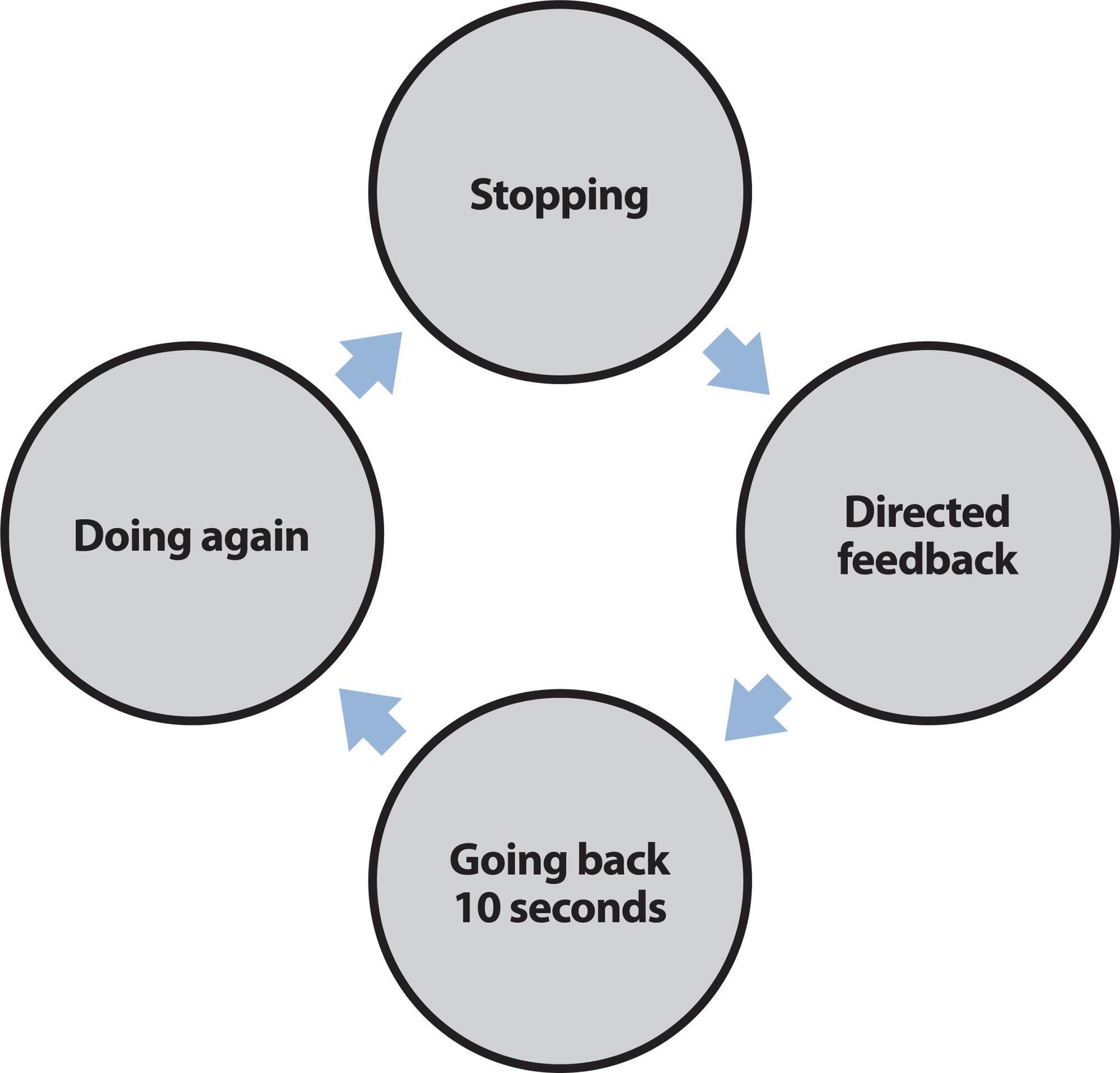
-
ORIGINAL ARTICLE08-19-2019
Interruptions and nursing workload during medication administration process
Revista Brasileira de Enfermagem. 2019;72(4):1001-1006
Abstract
ORIGINAL ARTICLEInterruptions and nursing workload during medication administration process
Revista Brasileira de Enfermagem. 2019;72(4):1001-1006
DOI 10.1590/0034-7167-2018-0680
Views0See moreABSTRACT
Objective:
To investigate the sources and causes of interruptions during the medication administration process performed by a nursing team and measure its frequency, duration and impact on the team’s workload.
Métodos:
This is an observational study that timed 121 medication rounds (preparation, administration and documentation) performed by 15 nurses and nine nursing technicians in a Neonatal Intensive Care Unit in the countryside of the state of São Paulo.
Resultados:
63 (52.1%) interruptions were observed. In each round, the number of interruptions that happened ranged from 1-7, for 127 in total; these occurred mainly during the preparation phase, 97 (76.4%). The main interruption sources were: nursing staff – 48 (37.8%) − and self-interruptions – 29 (22.8%). The main causes were: information exchanges – 54 (42.5%) − and parallel conversations – 28 (22%). The increase in the mean time ranged from 53.7 to 64.3% (preparation) and from 18.3 to 19.2% (administration) – p≤0.05.
Conclusão:
Interruptions in the medication process are frequent, interfere in the workload of the nursing team and may reflect on the safety of care.
-
ORIGINAL ARTICLE12-21-2020
Construction and validation of a mobile application for development of nursing history and diagnosis
Revista Brasileira de Enfermagem. 2020;73:e20190674
Abstract
ORIGINAL ARTICLEConstruction and validation of a mobile application for development of nursing history and diagnosis
Revista Brasileira de Enfermagem. 2020;73:e20190674
DOI 10.1590/0034-7167-2019-0674
Views0See moreABSTRACT
Objectives:
to describe the construction and validation process for a mobile application for development of the nursing history and diagnosis.
Methods:
methodological study conducted in 2018 in three stages: content creation, based on the Basic Human Needs categories and nursing diagnoses; content assessment by nine nursing judges, with calculation of the content validity index; and construction of the application, which included definition of the requirements, a conceptual map, implementation and prototyping options, tests and implementation.
Results:
the application was organized by sections: Grouped Basic Human Needs, Cranial pair tests, Clinical assessment scales and Additional tests. Two section were adjusted according to the judges’ suggestions.
Final Considerations:
it is the first application produced in Brazil based on the Basic Human Need categories, which enables quick access to information, concepts and typical nomenclatures of semiology, recording of clinical data and definition of nursing diagnoses.
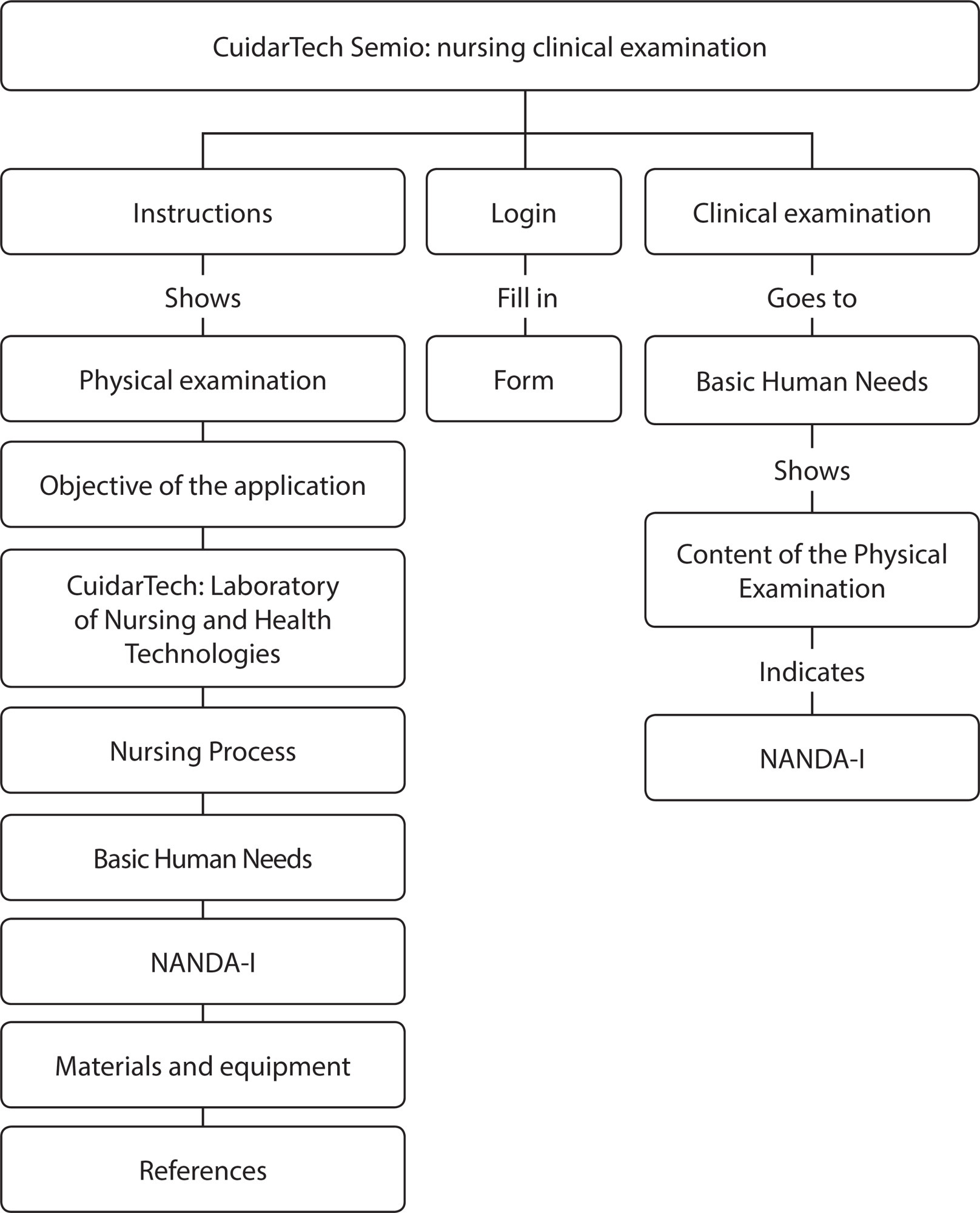
Search
Search in:
Nuvem de Tags
Adolescente (85) Atenção Primária à Saúde (239) COVID-19 (91) Criança (91) Cuidados de Enfermagem (269) Educação em Enfermagem (151) Educação em Saúde (139) Enfermagem (930) Enfermagem Pediátrica (86) Estudantes de Enfermagem (77) Estudos de Validação (131) Família (87) Idoso (208) Promoção da Saúde (99) Qualidade de Vida (104) Saúde do Trabalhador (86) Saúde Mental (145) Saúde Pública (82) Segurança do Paciente (150) Tecnologia Educacional (100)



